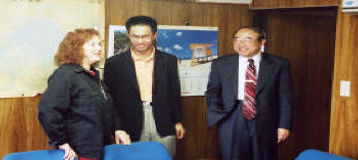Leading Australian grower and supplier of Carnivorous Plants and Water Plants.

Our Mail Order sales are now closed until Saturday 17th January 2026.
We wish all of our customers a very Merry Christmas and a safe and Happy New Year.
Please visit our Mail Ordering Conditions
page for more info.
THE FOURTH INTERNATIONAL CARNIVOROUS PLANT SOCIETY CONFERENCE
By Colin and Tina Clayton
of Triffid Park
JAPAN

Tina Clayton selling Carnivorous Plant books
at the 4th ICPS Conference

Tina with Yusuke Kondo (far right) in his board room
and his son Kosuke Kondo.

Colin meets up with long time customer
and friend, Naoki Tanabe.
June 21~June 23, 2002
Held at the National Science Museum in cooperation with Insectivorous Plant Society
Chairperson Prof. Katsuhiko Kondo
What a conference, what a venue, what speakers, what a culture!
To the uninitiated, Tokyo's rail system defies comprehension, and to get from the airport to the conference lodging required a combination of luck, Harry Potter's magic, having the right Japanese coins, finding the right ticket machine, and the right platform. A combination almost impossible to achieve. Fortunately we had the services of Kosuke Kondo, who met us at the airport and guided us through seven changes of trains, and a taxi ride, before we finally arrived at our lodging. [Thank you Kosuke, for without you I think we would be listed as missing in action.]
The conference and venue was beyond all expectations, with an interesting combination of academics, proliferating on both the practical and the theoretical.
Triffid Park's involvement was to present our full range of in, and out of print, books - 52 different in all. Sales were good, despite the language and currency conversion problems. Here Tina's international expertise and diplomacy came to the for, ironing out problems and explaining in English, to Japanese only speaking clients, that they could not buy our samples until the last day, as we needed these to take orders from.
Renewing past acquaintances, and meeting long standing clients, were to me, the highlights of the conference, and the reason to attend these far flung events. Having attended all 4 international conferences, it is evident that few, self-funded attendees, have the financial resources to continually attend these functions. University funded Professor lecturers are great, but once their funding dries up, they are never heard of again. Perhaps some financial assistance or incentive to the long standing stalwarts, should be considered. One observation is that, from the four international conferences, none of the world's leaders in carnivorous plant horticulture, have lectured us on how to grow these fickle plants.
My closing words are to thank Professor Katsuhiko Kondo, and heap praises on him for a truly fantastic conference.
We haver the full proceedings of the Conference for sale on our Book page - under Technical.
Title - Procedings from the 4th International Carnivorous Plant Conference, Tokyo, Japan,
Author - Edited by Katsuhiko Kondo
FIELD TRIP TO MT KOUSHIN, JAPAN,
TO SEE PINGUICULA RAMOSA GROWING IN ITS NATURAL HABITAT
The pale glow of dawn's first light was still 2 hours away, when the wake up call came. Yes, it was time to leave our warm soft futon [Japanese bed] after spending the short night at the traditional Japanese Inn at the base of Mt Koushin. A very demanding 5 hour hike confronted the stalwart party. Assembled after the 4th International Carnivorous Plant Conference, approximately 20 climbers were to take part in a post conference field trip to see the legendary Pinguicula ramosa.
Hash House Harriers we could have been, with our motto "ON, ON, ON". However, the rest stops got longer, and more frequent, as we neared our goal. Halfway up we met a diminutive Japanese gentleman who's back pack solely consisted of a 20 kilogram album of photos of Pinguicula ramosa, taken in all seasons, over the past 20 years. He had camped out overnight to get perfect morning light for photographing them in flower. No camping gear was evident - how had he survived? Well, this was answered 20 minutes later, when we met his slight, 4 ft 6 in. wife, who carried 50 kilograms of EVERYTHING - bear bells, lap top computer, shark repellent, a small Shinto Shrine, tent, stove, etc. - WHAT A WOMAN!
At last, the home of Pinguicula ramosa, was within our grasp. AND THERE THEY WERE!! Tiny plants, clinging precariously to an overhanging decomposing granite cliff, and extremely difficult to photograph, because they were just out of reach. What incredible timing, for they were in full flower, with their classic twin arched stems, each supporting a pristine bloom. We were unprepared for their tiny size, and could not help but wonder how these frail plants could exist, as drops of water on them, such as rain, was instant death. [They survive by living on seepage water, protected from rain by the overhanging cliffs.] Their dense seeds, with no aerodynamic assistance, must somehow adhere to the cliffs whilst germination occurs, which must take at least 6 months. Hundreds of photos were taken, lunch was eaten, and sadly the downhill trek was started. Sad, because we realized that few of us would pass this way again.
Technical:
GPS 36° 38.996 N, 139° 22.524 E. pH 7.7. T.D.S. 0. Altitude 5,523 feet. About 2,000 plants scattered over 200 metres of cliff face.
Postscript:
On a nearby cliff, Pinguicula ramosa recently became extinct, because of climatic change.

Colin having a rest on the hike to see Pinguicula ramosa.

Pinguicula ramosa growing on a cliff wall.
